

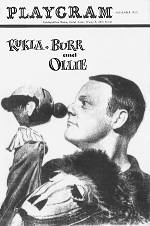 In 1960, Burr finally realized his long-time dream of bringing
the Kuklapolitans
to Broadway, when "Kukla, Burr and Ollie" opened at the Astor
Hotel in
Times Square. Larry Smith worked with Burr on the show,
and in February
of 2000 he related the story of their experiences in New
York. The
Kuklapolitan Webpage is pleased to offer the memories and
photos he shared
with us.
In 1960, Burr finally realized his long-time dream of bringing
the Kuklapolitans
to Broadway, when "Kukla, Burr and Ollie" opened at the Astor
Hotel in
Times Square. Larry Smith worked with Burr on the show,
and in February
of 2000 he related the story of their experiences in New
York. The
Kuklapolitan Webpage is pleased to offer the memories and
photos he shared
with us.Larry Smith debuted as a televison puppeteer while still a teenager in Ohio and has created numerous shows, including The Rudy and Teaser Show, Jamboree, and The Contemporaries. He is still busy with personal appearances and special events. Click here for more info on Larry.
When did you first become involved with puppetry?
Well, I was born in 1938 and started making puppets when I was 5 and a half years old. I was always working with puppets, trying to make my own because they were too expensive to buy. Then television came along, with Kukla, Fran and Ollie, and Howdy Doody, and I watched every day. I didn't get all the adult references in KFO, but I loved all their projects, when the Kuklapolitans would be building stuff and making something - of course, that was just Burr stalling for time!
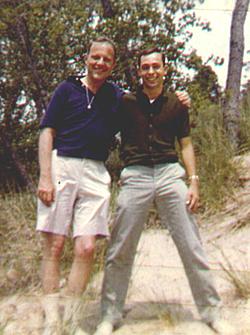 When
did you meet Burr?
When
did you meet Burr?
He came to Bowling Green University in Ohio for the National Puppetry Festival in June of 1955 and performed "St. George and the Dragon," which he would later use in the Broadway show. I remember that it wasn't air-conditioned, and it was so hot Fran said she nearly died. After the show, George Latshaw introduced me to Burr. But all the puppets had already been packed away - you couldn't see the puppets, that was the thing.
How did you start working with him?
The next year I visited Northwestern University in Evanston, just outside of Chicago, and Burr did an impromptu show there for the Puppeteers of America. I had gotten to know Burr and his parents over the summer, so when Burr decided to do "Lemonade" at the last minute and needed props, he asked me to run to the cafeteria and get a pitcher and a little pot of sugar, etc. And then during the show, I just handed him what was needed - I could tell which characters he was going into. I was a nervous wreck, since I was only 17 or so and Burr was like an icon to me.
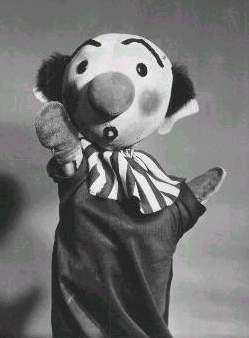 Burr
did some pretty fast changes backstage, right?
Burr
did some pretty fast changes backstage, right?
Oh, yes - you had to help him get Kukla's hands on. It was a crazy thing - why he did that all those years, I'll never know - but Kukla's hands were attached to the puppet with just a small piece of cloth, and you had to be sure he got his fingers in them. Sometimes, he even had to use his teeth to get them on.
When did you next meet?
In 1960, I attended a National
Puppetry Festival at the Detroit Institute of Art, on my way
to New York
City for a vacation. Burr was staying at the same hotel,
and we became
good friends. After the festival, Burr said, "Why don't
you and Jim
and Jane Henson (they had their first baby at the time), come
over to Saugatuck
and spend the weekend with me? Well, there went my New
York trip!
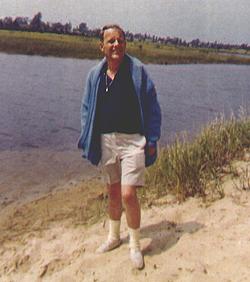
So I drove over with the Hensons
in their Rolls-Royce - it wasn't the newest Rolls-Royce, but
it was a Rolls-Royce.
They stayed at a hotel downtown, and I stayed with Burr at the
Oxbow Summer
School of Painting. He knew everybody up there - he'd
walk around
town with an ice cream cone and talk to everyone in town; it
was his second
home. We'd go to the Red Barn Theatre, and he knew all
the theater
people. And swimming - he loved to go swimming early in
the morning.
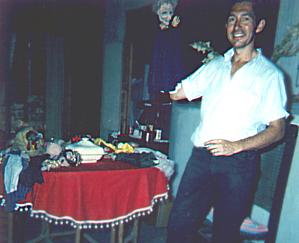
Was he getting ready for the Broadway show then?
Oh yes - Don Sahlin was there, rebuilding the puppets. They had been made out of cloth, but now the technique was to use molds and make the puppets out of celastic covered with cloth, so he could make duplicates. He needed an extra Kukla for "St. George," and such. So I helped, and before I left Burr invited me to join him on Broadway.
Did you accept right away?
First, I went back to Cincinnati, where I was working on a few television shows. I did a show at 8 in the morning, and then worked on the "Uncle Al" show at 9. Then we did another show from 11 to 12, which had just gone off the air, so it was perfect timing for me. My contract was up, and they wanted me to take another show in the afternoon. But I was thinking about Burr's offer to go with him to Broadway.
Then a good friend at the Cincinnati Post, Mary Wood, placed a blurb in the paper: "Sept. 14, 1960: Larry Smith, channel 9's popular and young puppeteer has had an offer from Burr Tillstrom to join the cast of Tillstrom's forthcoming Broadway show, An Evening with Kukla, Burr and Ollie." That's all that was said. And that got everyone at the station right on their feet! But by that time, it was too late - I had already sent a telegram to the show's producer, Cheryl Crawford, accepting the job.
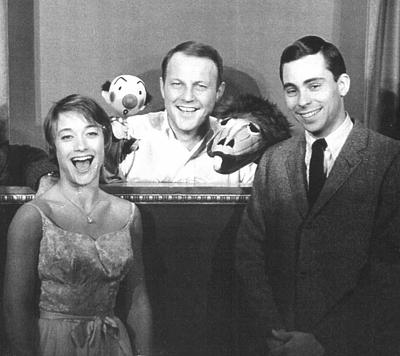 So
who went to New York with Burr?
So
who went to New York with Burr?
Just the three of us - I was 22, Don was 32, and Burr was 42. George Bauer, the pianist, and Claiborne Cary, who took Fran's part, were there already. He had some other people who were friends of his from Chicago who came along for nothing. They helped out with the costumes, but I can't recall their names.
Joe Lockwood?
No, but he came to one of the shows.
How did Burr find Claiborne Cary?
He held auditions. She had done some Broadway stuff and knew the pianist. She was very nervous about it, but she was good.
Do you know how the idea for the show came about?
The show had been planned for years. It was supposed to happen prior to this - Beulah Zachary flew to New York to set it up, and was killed when her plane went into the East River. Burr would talk about that every now and then: "We stayed up all night praying." Her death really hurt Burr - she was such a comforting person to him.
And after Beulah died, Cheryl Crawford took over as producer?
Yes - I don't know whether she came to him or vice versa, but he ended up with her and Joel Schenker in New York.
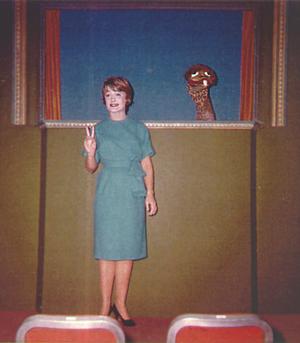 Was
the show developed in Saugatuck or in New York?
Was
the show developed in Saugatuck or in New York?
We didn't put it together until we got to New York. He had done previews of it in other places, and had performed "St. George and the Dragon," of course, but he kept changing the rest of the show and the music. And he didn't get along with the pianist. He ended the show with one of his "hand ballets," and he would fight constantly with the pianist; that he wasn't following him. The pianist was trying his best, but he almost walked out!
How was the Astor Hotel chosen for the show?
Cheryl and Joel set all that up. The show was held in the Green Room overlooking the lobby, and there was a bar connected to it. The actual room used for the theatre had been a dining room - they put the puppet stage at one end of it, the kitchen became our workshop, and Burr had his dressing room off stage left.
Did the theater have rows of seats or tables?
Rows of seats - and he complained
about them. "I'm not going to do this show..." -
that's the
way he would get - "...until you get better seats in
here!" So they
got padded seats, about 200 of them, in tiers.
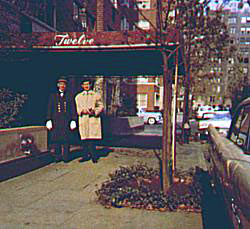
Where
did
all of you stay in New York?
Tillstrom had gotten a place
at 12 Beekman Place - two floors, looking out over the East
River.
Don Sahlin and I both stayed with him - he had the upstairs,
and we had
the downstairs. We were both going to eventually get our
own apartments,
once the show settled in.
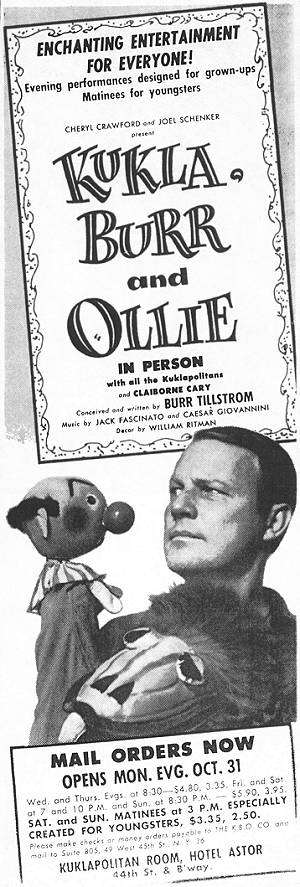 What
were rehearsals like?
What
were rehearsals like?
It was so crazy. They kept pushing back the opening date, because we were still trying to get the seats in, and the stage and lights right, and everything. We had to open by October 31st - for some reason, that was a deadline. Kind of strange, since it was Halloween.
Burr was such a happy person back in Michigan, but now he fell on my arm and cried, "Oh my god, Larry, why didn't we just stay in Oxbow? What am I doing here?!" He would do that - he would just fall apart, telling people he wouldn't do the show, he was just going to walk out. One night I went out to get him a milkshake or something and he nearly went nuts: "Where's Larry?!" He'd be a nervous wreck, but when he finally got on, he was just a marvelous entertainer.
I loved being in New York, though - it was an adventure to me. I would go out after the show and hit the Village. Not Tillstrom - he was exhausted. One time, we went to Lindy's after a preview. Burr would always carry this old beat-up leather case with all the puppets in it, and we'd take them back to the apartment. Well, we were all so tired - I left to get into the cab and said, "Oh my God! I left the puppets in the restaurant!" Thank God they were still there or I would have taken the first flight out of there! Burr just said, "Oh, that's all right..." It nearly destroyed me, though.
I remember one night we were
all leaving for home after rehearsal, and I said, "I'm going
to try a different
way, to see if it's quicker." I got home, and they
didn't come back,
and didn't come back - well, they had run into Gypsy Rose Lee
on the way
home, and she invited them up to her apartment. I guess
they were
good friends. They got to see the marble bathtub I had
heard about
for years - I'll never forgive myself for missing that!
I finally
did get to meet her when she was doing a show down at the
Cherry Lane Theater
in the Village. She showed 16mm film clips of her
career, and her
son ran the projector. She came out, very busty, and
said, "Oh, excuse
me, I have to get my glasses out." Of course, they
were right
between her breasts, and she'd say, "Oh, my - they're all
foggy!"
I loved that stuff.
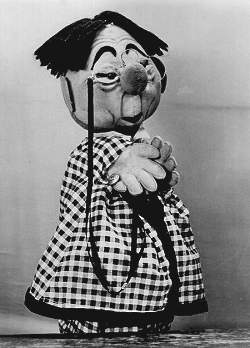 So
by this time the previews were going well?
So
by this time the previews were going well?
Well, there was one preview when Colonel Crackie was announcing "St. George and the Dragon," and he pounded this little hammer and said "Quiet! Ah say, mah friends, quiet, QUIET!" And he hit that hammer and his head flew off! Don Sahlin (who had just finished re-making that puppet), says "Oh, Burr, I'm so sorry!" and Burr is just, "Wha? Wha?" He was standing there with this headless thing! And he finally pulled it down and there was laughter in the audience. Well, the pianist picked it up and threw it to Don backstage, and Don threw it to Burr, who put it back on and went back up.
Colonel Crackie composed himself and said, "Well, a li'l more thrust and I'd a' been in orbit!"
People said he should leave
it in, but Burr wouldn't do it.
What was opening night like?
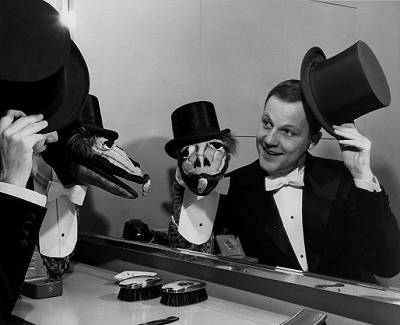 You've
never seen so many telegrams as filled up his mirror on
opening night!
I was a nervous wreck. Everyone was there - I recall
Carol Channing,
Phil Silvers, Tallulah Bankhead. Tallulah came backstage
after the
show to meet Burr, and Fran Allison was there. Fran was
not able
to do the show - she had been having some more facial surgery,
I think,
to repair damage from an automobile accident years ago.
You've
never seen so many telegrams as filled up his mirror on
opening night!
I was a nervous wreck. Everyone was there - I recall
Carol Channing,
Phil Silvers, Tallulah Bankhead. Tallulah came backstage
after the
show to meet Burr, and Fran Allison was there. Fran was
not able
to do the show - she had been having some more facial surgery,
I think,
to repair damage from an automobile accident years ago.
So Tallulah comes up to Burr and says, "Oh dahling, I kiss your fingers!" - she always did that with Burr - and turns to Claiborne Cary and says, "Oh, Claiborne, you were ten times greater than Frannie ever was! Oh, hello, Fran..." Everyone just broke up - only Tallulah could pull something like that off.
But everyone was so relieved at that point - it had come off, after all those problems: the seats, the lighting and the staging, the opening date. I remember the next morning, I was reading the reviews to friends in Cincinnati, saying, "Well, I guess I'm going to be here for awhile." The reviews were great.
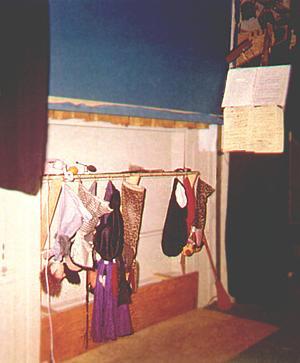 Did
both Don and you work backstage every night?
Did
both Don and you work backstage every night?
Yes - Don was better with some of the stuff. Like Ophelia's hair - it had to be curled just a certain way, but I never went to beautician school! Also, for the Dragon Prep number, we made extra dragons, which Don and I performed in the two small stages on the sides. And then after each show, we had to air the puppets out with a blower. Of course, Tillstrom had people doing that stuff for him for years - he just walked in and did the shows.
Burr was also thinking of adding new characters to the show - one character that I had created named "The Prown Crince of Eenie-Meenia." And he also wanted Don and I to do the Saturday Matinees for children, but that never happened.
What were the audiences like after the opening?
Well, he had his fans, but unfortunately once they got their fill of it, attendance dropped. It was not your usual Broadway crowd - his fans were there for the first couple of weeks, and then it began falling off. We closed on November 20th. They say that if he had done it in the Village, he would have had a better chance. Broadway was just too expensive. Even I had to join Equity (the actors' union), in order to perform with the show.
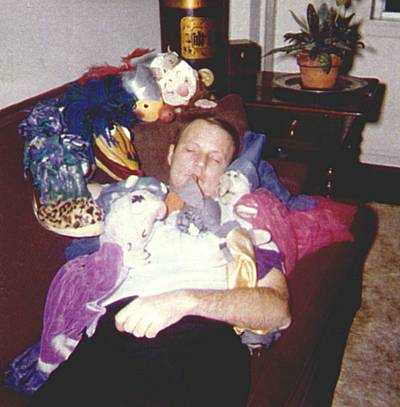 How
did Burr react?
How
did Burr react?
Well, he was hurt, but he was an optimist. This is something he had tried to do for so long, and he had finally done it. I remember the last performance - he did a closing piece, where each character was going somewhere different. It was a sad time, because we hadn't expected it, what with the good reviews.
And when it came time to pack up, we didn't know how we were going to get out of that place. He had moved his whole workshop backstage - costumes, props, everything. Well, they had these men come in, and they put belts around themselves, and within a half hour, it was all moved out.
As we were walking out, he took the Cheshire Cat he had made for the NBC production of "Alice in Wonderland" - he had played the Mock Turtle - and he said, "Let's just leave that thing here." So he put it up high in one of the palm trees outside the theatre door, looking down at all the people in the lobby as we left.
He stayed in New York, and
began doing his five minute show for NBC. I was home by
Thanksgiving,
and the station I had left took me back and paid me double!
Did you stay in touch with Burr?
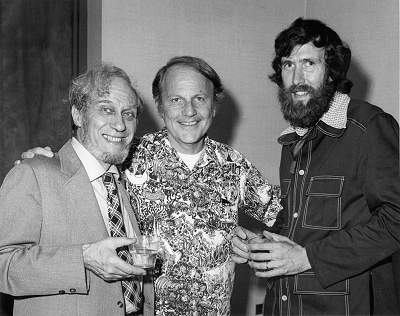 Sure.
We'd meet at the festivals. I remember in 1973 Burr was
getting the
President's Award at the National Puppetry Festival, at
Michigan State
University. Bil Baird was there, and he played the piano
late one
night and kept Burr up. The next morning Burr complained
to me, "Those
people! Playing the piano all night!"
Sure.
We'd meet at the festivals. I remember in 1973 Burr was
getting the
President's Award at the National Puppetry Festival, at
Michigan State
University. Bil Baird was there, and he played the piano
late one
night and kept Burr up. The next morning Burr complained
to me, "Those
people! Playing the piano all night!"
And I said, "Burr, that was Bil and me..."
"Well, I'm not going to that awards ceremony."
"Burr, it's very important that you go, and I suggest you wear a nice coat..."
"Oh. Oh - well, what do you think I should wear?" That's the kind of friends we were.